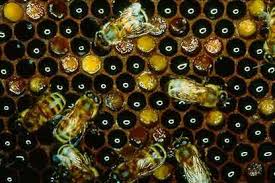
After repeated use, old brood combs can become very dark—nearly black. The inside diameter of each cell also becomes smaller because the cocoons of each succeeding generation are glued to the cell walls. Even though the cells are polished by nurse bees before new eggs are laid, some of this cocoon material remains.
Pesticides and disease organisms can reside in both the wax cells and the cocoon layers. The darker the cells get, the higher the probability of contamination. It is recommended that very dark combs be cut away and discarded. In the past beekeepers could keep combs in use ten or twelve years and it was a point of pride to do so. With the use of pesticides and the ever-widening array of honey bee diseases, that philosophy has changed.
One of the easiest ways to rotate old comb out of your supply is to decide on an annual schedule of replacement. If you replace the worst 20% of your combs every year, you will rotate your entire stock once every five years. Some beekeepers prefer to replace 25% every year for a four-year rotation.
When doing a hive inspection if noticing a particularly bad comb, mark the top bar with a felt-tip pen so it can be found later. Then, before spring build-up when both stores and brood nests are small, go through the hives and pull out the 20% to be discarded. Since the brood nests are small, it is easy to equalize the boxes so that each box has eight frames remaining.
The empty slots can be replaced in several different ways. You can use new frames or you can cut out the old comb and reuse the frames if they are not too bad. You can use foundation—or not—just as you normally do. Some beekeepers prefer to have all new frames made in advance and then just drop one in and pull an old one out.
The system is not perfect. You will always find a hive where all the brood for the entire colony is on the one worst comb. Don’t worry about it—just leave that one there and remove the worst frames that don’t contain any brood. Even with those few exceptions, you will still be providing a healthier environment for your baby bees.
